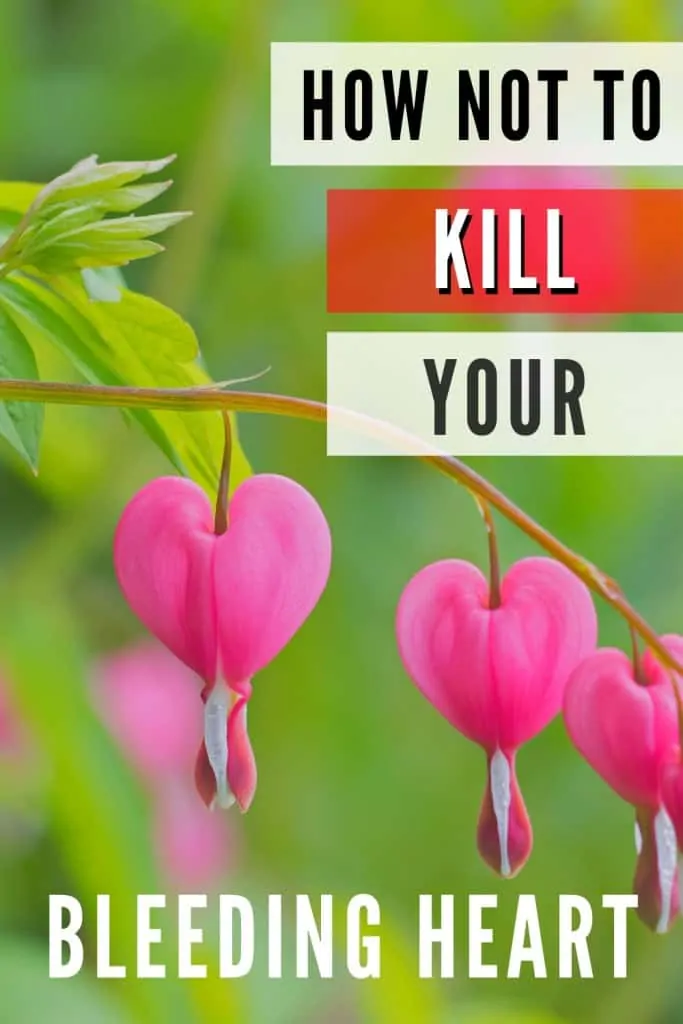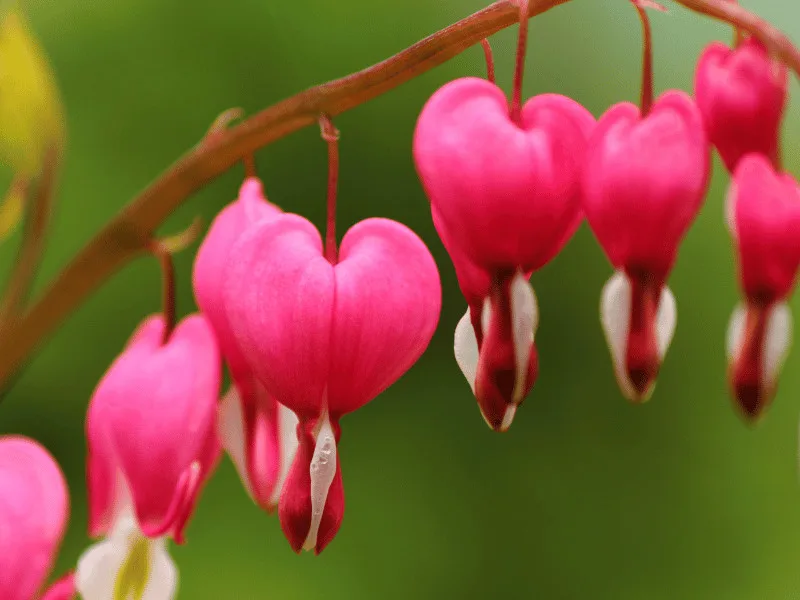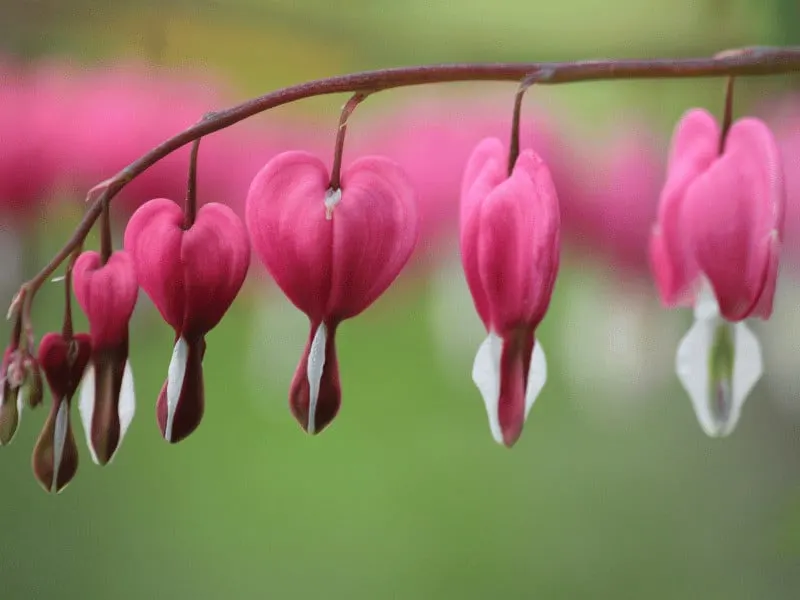You are reading this guide to learn more about the Bleeding Heart plant and its care.
What is the Bleeding Heart Plant?
The Bleeding Heart Vine goes by the scientific name Lamprocapnos spectabilis. They are iconically named for the heart-shaped flowers. They can range from a deep pink to white. This perennial originates from northern China, Korea, Japan, and Siberia. They are closely related to members of Papaveraceae or Poppies.
These whimsical floras are pretty hardy despite their delicate morphology. The Heart vine plant is toxic and contains chemical isoquinoline alkaloids.
Bleeding Heart Care
The Bleeding Heart plant prefers soil rich in organic material and good drainage, and it thrives in partial shade with morning sun. It requires a moderate watering schedule, keeping the soil well-saturated but not waterlogged, and is best kept at temperatures between 60-75 degrees Fahrenheit (15-24 degrees Celsius).

Takeaways
| Species | Lamprocapnos spectabilis |
|---|---|
| Synonyms | Bleeding Heart, Asian Bleeding Heart, Dutchman’s Breeches, Lady’s Locket, Lyre Flower |
| Family | Papaveraceae |
| Genus | Lamprocapnos |
| Growth | Clumping perennial |
| Height | 2.0ft / 0.6m |
| Width | 2.0ft / 0.6m |
| Soil | Well-draining soil mix |
| Light | Bright indirect |
| Fertilizer | Once a year in spring |
| Propogation | Divide clumps in spring or fall, or sow seeds in early spring |
| Toxicity | Toxic to humans and animals such as cats and dogs. Contains isoquinoline alkaloids. |
| Watering | Every 3-7 days |
| Temperature | 50.0 – 75.0°F / 10.0 – 23.9°C |
| Humidity | 40.0 – 60.0% |
Table of Contents
Bleeding Heart Care Guide
As a whole, the plant is known for needing little maintenance during its lifetime. Also called the Asian Heart, according to NC State Extension, they even need less care during the growing season than most flowering plants. I’ve outlined the various needs that should be met to meet the minimum requirements of a Dicentra spectabilis.
Soil
The Bleeding Heart plant is particular about the type of soil it is placed in. It should be rich in organic material, namely humus. Both sand and clay can be added for a more beneficial setup.
This soil should be fairly neutral to increase potential fertility. It also needs to be able to drain properly since sitting in water for too long can damage the root system.
Light

A member of Papaveraceae, they enjoy a sunny morning followed by plenty of shade in the afternoon. The Bleeding Heart plant somewhat follows this rule.
Raising a Dicentra spectabilis indoors is not all that tricky. These plants will thrive when placed in bright, indirect light. Heat exposure tends to be a larger issue than not getting enough light.
Bleeding Heart Water Requirements
Water every 5-7 days using 1 inch of water.
The Bleeding Heart prefers well-saturated soil without being overrun with water. When a Bleeding Heart is planted, it must be watered well to allow the roots enough moisture to grow.
During the first season of growth, a Bleeding Heart plant will require regular watering. New plants need to be watered every day for the first week.
For the remainder of their lifespan, they will be fine with an inch of water per week during the growing season.
They tend to have a higher risk of drying out from early spring to winter when temperatures are higher.
Bleeding Heart Temperature Range
The ideal temperature for a Bleeding Heart is 60-75 degrees Fahrenheit (15-24 degrees Celsius).
Humidity

The Bleeding heart plant prefers high humidity between 50-70%.
Having too much moisture in the air is not a big deal for a Dicentra spectabilis. Without the proper humidity, these plants are known to go into a state of dormancy, especially during the winter months.
Use a humidifier if you’re worried about your Bleeding Heart not getting enough moisture.
Fertilizer
Fertilize once in spring using an all-purpose fertilizer.
The natural life cycle of a Bleeding Heart is to bloom during the spring and die around midsummer.
This differs from most perennials, which usually go into a dormant state after the flowers have developed.
The use of a fertilizer can aid in a heavier bloom before it dies off. Using a single application is all you need, as these Papaveraceae members aren’t food-hungry.
Propagation
You can propagate the Bleeding Heart through seed germination, root cuttings, and division.
I suggest root cuttings out of these techniques, as it only takes a few days to see initial growth. The whole process is anywhere from one to three weeks in total. We will have more detailed instructions later.
Root-Cutting Propagation Step-By-Step
- Using sharp scissors, make three to five-inch cuts (12.7 cm) along the stem of a healthy Bleeding Heart plant. Remove all of the leaves along the stem that are on the bottom half.
- Put the newly cut section face down into a pot with fresh potting mix. This is when you dip the open end in rooting hormone before pushing it into the soil.
- Place a clear plastic bag over the potted plant to increase the humidity and add holes for proper ventilation.
- Put the cutting in a spot that gets indirect sunlight so the leaves don’t burn.
- Keep an eye on the soil. Add a few inches of water every few days, especially if your house gets lots of sun.
- Once your plant has rooted within 2-3 weeks, you can transfer it to a bigger pot.
Growth
Lamprocapnos spectabilis reaches a height of 36 inches (91 cm). They grow up to 3 feet wide (91 cm).
You can expect your indoor Papaveraceae to reach its full size at around three years of age. Their total life span spans from five to eight years.
The Bleeding Heart plant is delicate in both the flowers’ morphology and size.
Potting
The general rule that one can follow regarding repotting their Dicentra spectabilis is about once or twice a year.
This is mostly due to the roots that can become cramped, despite being a woodland plant. Without repotting, growth will be stunted. Transferring them to another plant takes special attention.
The roots are sensitive to being over-handled. Most Bleeding Heart owners will use the division propagation method to avoid changing it.
Bleeding Heart Pests
The Bleeding Heart plant is privy to several pests, even if they live indoors. Understanding what types of bugs may attack their foliage can help you prepare for the future.
Among the most typical pests to pick on your Papaveraceae individual are aphids, slugs, snails, and something called scale. As the name suggests, scale involves the leaves and stems becoming scale-like.
Using soapy water can solve all of these pest problems. This can either be bought in the store or made at home. It involves hand-plucking the pests and placing them into the solution bucket.
You can also directly spray this onto the leaves themselves. You will need to follow it up with clean water so the plant does not face damage.
Another predisposed issue that the Bleeding Heart may face is root rot. This is the result of a plant sitting in water for too long. We have an extensive article on Root Rot Treatment for those interested!
Bleeding Heart Problems
Normally quite hardy despite their appearance, the Bleeding Heart can experience several problems. Identifying the early signs will aid you in combatting the issue before it becomes irrevocable.
Here are the two most commonly identified hints that your Papaveraceae is struggling.
Yellow Leaves
Cause: The leaves of a Bleeding Heart plant are generally a vivid green. If you notice them shift to a yellow hue, your plant is likely getting too much water. This can sometimes be paired with faded tints.
Remedy: To combat this problem, you’ll want to adjust your watering schedule.
Remember that the soil should be moist, not overrun with moisture. Try allowing your plant to dry out and then start off by watering every few days. Check the soil dryness with your finger to pinpoint a better watering routine.
Curling and Browning Leaves
Cause: There may be times when you see a couple of signs hinting at one problem. Leaves that turn brown and curl at the tips generally indicate a light issue. It can also mean that your Bleeding Heart plant has aphids.
Remedy: First, tackle the light issue, placing your plant in a spot with bright, indirect sunlight. If that doesn’t work, move on to the aphid infestation. Insecticidal soap applied to the affected leaves will rid them of these pests.
Bleeding Heart Care in Fall
After the Bleeding Heart dies between July and August, clean up all the dead foliage in fall. These plants will return in Spring.
FAQ
Do Bleeding Hearts come back every year?
This Papaveraceae member is unlike most perennials, as they tend to stop blooming mid-summer. Usually, this dormant period happens around the later end of fall and winter. Bleeding Hearts return yearly, starting their first bloom in the late winter.
Should you deadhead Bleeding Hearts?
Fortunately, the Bleeding Heart plant will bloom again, even without the task of removing the dead flowers. Pruning can benefit overall growth, but it is generally implemented to gain aesthetic appeal over any practical use.
How many varieties of Bleeding Heart plants are there?
There are two Lamprocapnos spectabilis (formerly known as Dicentra spectabilis) species. The main difference between the two is their flowers. One sports a combination of white and pink flowers, while the other produces white blooms.
A Hearty Conclusion
The Bleeding Heart flower is spectacular and a great plant to plant and care for in the garden and indoors.

Daniel has been a plant enthusiast for over 20 years. He owns hundreds of houseplants and prepares for the chili growing seasons yearly with great anticipation. His favorite plants are plant species in the Araceae family, such as Monstera, Philodendron, and Anthurium. He also loves gardening and is growing hot peppers, tomatoes, and many more vegetables.


